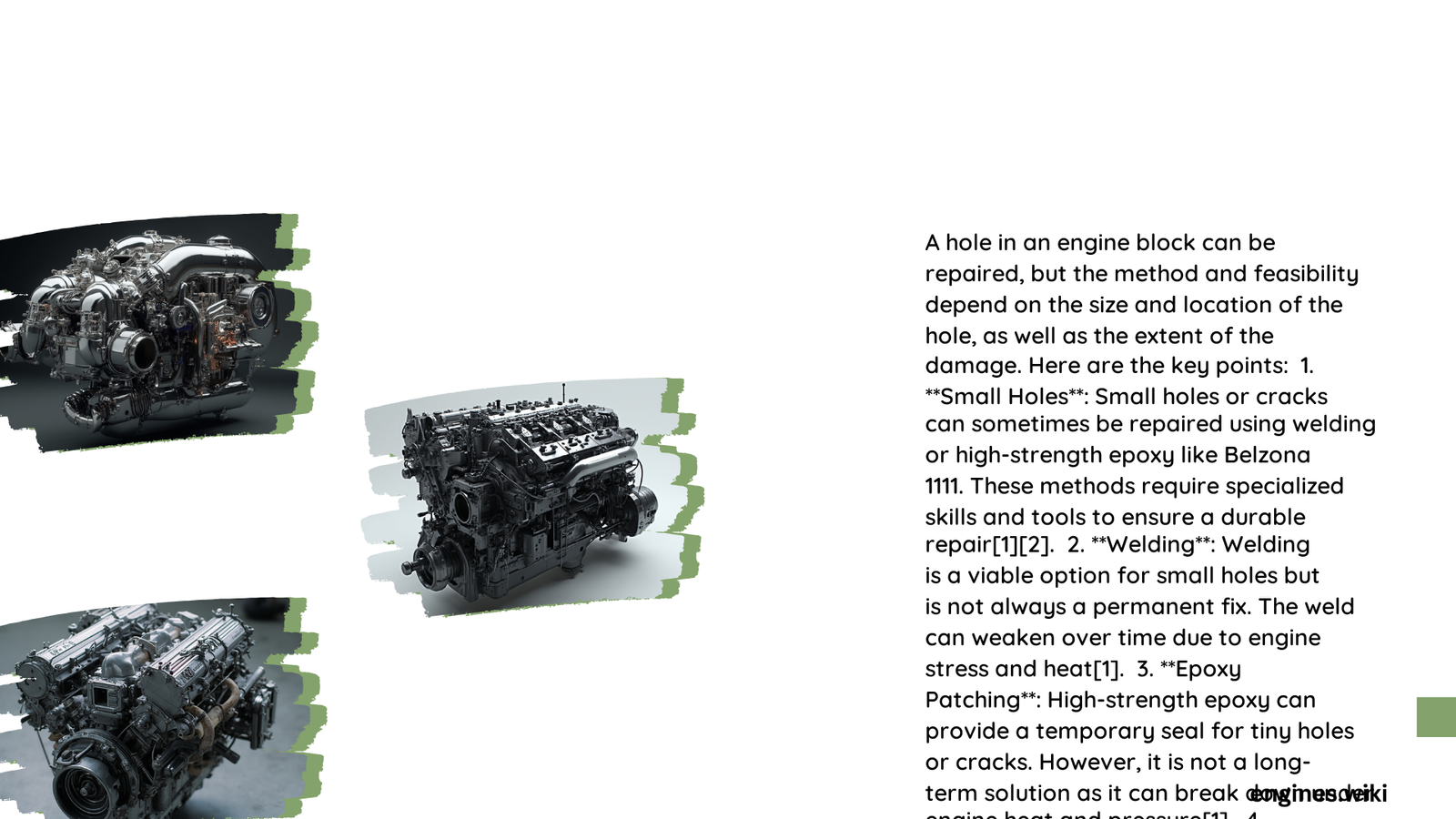Engine block damage can be a serious concern for vehicle owners. A hole in the engine block, whether caused by corrosion, mechanical failure, or external impact, can lead to significant performance issues and potentially render the engine inoperable. However, the question remains: can a hole in an engine block be repaired? The answer is yes, in many cases, a hole in an engine block can be repaired using various techniques such as welding or epoxy sealing. The success of the repair depends on factors like the size and location of the hole, the engine block material, and the chosen repair method.
What Are the Main Methods to Repair a Hole in an Engine Block?
There are two primary methods for repairing a hole in an engine block:
- Welding
- Epoxy sealing
Each method has its advantages and is suitable for different types of damage and engine block materials.
How Does Welding Repair an Engine Block Hole?
Welding is a common and effective method for repairing holes or cracks in an engine block. Here’s a breakdown of the welding process:
- Preparation:
- Clean the area thoroughly
- Remove all contaminants
-
Drill small holes at crack ends to prevent propagation
-
Welding Types:
- MIG (GMAW) welding
-
TIG (GTAW) welding (preferred for cast iron blocks)
-
Filler Materials:
- Nickel-based filler rods for cast iron blocks
-
Reduces risk of further cracking due to thermal stress
-
Procedure:
- Bevel hole edges
- Apply tack welds
- Braze or weld the patch in place
- Perform pre-heat and post-heat treatments
What Are the Steps for Epoxy Sealing an Engine Block Hole?
Epoxy sealing is another effective method, particularly for smaller holes or cracks. Here’s the process:
- Materials:
- High-strength epoxy (e.g., Belzona 1111 Super Metal)
- Reinforcement tape (e.g., Belzona 9341)
-
Degreaser (e.g., Belzona 9111)
-
Application:
- Clean the area with degreaser
- Drill holes to terminate cracks
- Insert and trim studs
- Vee out cracks and roughen the area
- Apply epoxy material
- Use reinforcement tape wetted with epoxy
-
Build up repair area with additional layers
-
Curing:
- Allow epoxy to cure completely (several hours, depending on product and conditions)
What Factors Affect the Success of Engine Block Hole Repair?

Several factors can influence the outcome of an engine block hole repair:
- Hole Size and Location:
- Smaller holes are generally easier to repair
-
Holes near oil or water passages present additional challenges
-
Engine Block Material:
- Cast iron blocks are more challenging to weld than steel
-
Epoxy repairs can be effective for both materials
-
Environmental Conditions:
- Temperature and humidity affect epoxy curing
-
Controlled conditions necessary for welding repairs
-
Repair Method Chosen:
- Welding may be more suitable for larger holes
- Epoxy sealing can be effective for smaller damage
What Are the Specifications for Welding Engine Block Holes?
When welding an engine block hole, consider the following specifications:
| Aspect | Details |
|---|---|
| Welding Type | TIG (preferred for cast iron), MIG (for steel patches) |
| Filler Material | Nickel-based filler rods for cast iron |
| Equipment | TIG or MIG welder, pre-heat and post-heat equipment |
| Preparation | Thorough cleaning, beveling of edges |
| Heat Treatment | Significant pre-heat and post-heat to prevent cracking |
How to Choose Between Welding and Epoxy Sealing?
Consider these factors when deciding between welding and epoxy sealing:
- Hole Size:
- Large holes: Welding often preferred
-
Small holes or cracks: Epoxy sealing can be effective
-
Engine Block Material:
- Cast iron: TIG welding or epoxy sealing
-
Steel: MIG welding or epoxy sealing
-
Skill Level Required:
- Welding: Requires specialized skills and equipment
-
Epoxy sealing: Generally easier for DIY repairs
-
Cost:
- Welding: May be more expensive due to equipment and expertise required
-
Epoxy sealing: Often more cost-effective for smaller repairs
-
Repair Duration:
- Welding: Can be quicker but requires cooling time
- Epoxy sealing: Requires curing time, which can be several hours
What Are the Challenges in Repairing Engine Block Holes?
Repairing a hole in an engine block can present several challenges:
- Accessibility:
- Some areas of the engine block may be difficult to reach
-
Holes near critical components require extra care
-
Material Properties:
- Cast iron is prone to cracking during welding
-
Proper heat treatment is crucial to prevent further damage
-
Precision:
- Repairs must be precise to maintain engine integrity
-
Improper repairs can lead to leaks or further damage
-
Long-term Durability:
- Repaired areas may not be as strong as the original block
- Regular inspection of repaired areas is recommended
In conclusion, while it is possible to repair a hole in an engine block, the success of the repair depends on various factors. Professional assessment is often recommended to determine the best course of action for your specific situation.
References:
1. How To Repair a Cracked Engine Block – Belzona Blog
2. How to Repair a Cracked Engine Block – YouTube
3. Hole In Engine Block (Complete Guide) – RedRoadMotors
4. Engine Block Repair – Welding Tips and Tricks
5. Can You Weld a Cracked Engine Block? – It Still Runs
